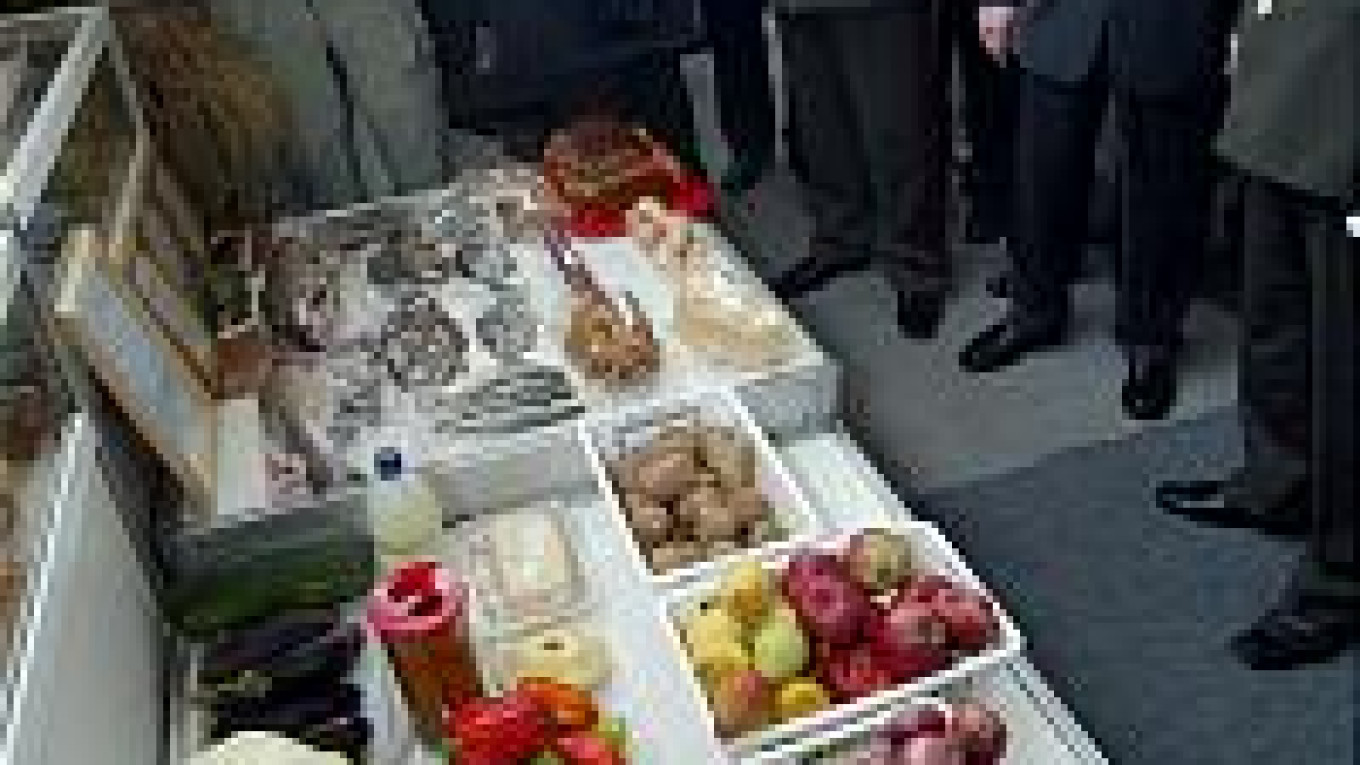You have to be arrested first.
The Russian prison service, as well as holding 850,000 people, is also one of the country's biggest producers -- as it feeds itself and provides goods that crop up in all walks of life. Turnover last year was a hardly insignificant $400 million.
Some prisons have their own farms, while others run factories and companies. In total the prison service has more than 650 enterprises where 300,000 prisoners work.
Most famously, prisoners make many of the airplane seats on domestic flights.
But starting last Friday, the state correctional department of the Justice Ministry, or GUIN as it is known by its Russian acronym, is showing off its other wares at a new exhibition at the All-Russia Exhibition Center.
"Goods and Technologies of Enterprises of the Criminal Justice System" is a weird mish-mash of an exhibition that shows the vast array of jobs that prisoners can do while serving out their time.
The wide array of goods produced through prison labor ranges from Sakhalin Island caviar to firemen's suits from central Russia and melons from Krasnodar.
Jostling for space are small wooden objects for use in the banya, next to large-scale machinery and office furniture.
Though lacking sophisticated presentation, the exhibition is clearly aimed at the potential business partner, rather than the curious passer-by.
Yet the seemingly random selection of goods makes it hard to escape the impression of a smarter version of Luzhniki market at times.
And like with any successful business, the chief executive is keen to promote his plans for expansion. According to Justice Minister Yury Chaika, who opened the exhibition Friday, the prison work service needs 20,000 extra inmates to man its industries every year.
All the "facilities of the enterprises are not fully up to speed," said Chaika, adding he hoped the exhibition -- which is expected to be permanent -- will attract investors in the enterprises.
But for such a large business, the workforce often leaves something to be desired.
"Because of changes to the Criminal Code, those who now end up in penitentiaries are those who have committed serious and very serious crimes," Chaika said. "These people have completely lost their working habits and skills. It means we have to teach them all over again."
The prison service reports production of more than 6 billion rubles' ($195 million) worth of goods so far this year, with double that amount over 2002.
But even this figure is dwarfed by the income from Soviet times of 6 billion old rubles per year, then equivalent to at least the same amount in dollars.
Alexander Kiselyov, a vice president of the Union of Industrialists and Entrepreneurs, said business is now taking more of an interest in using prison labor after largely overlooking its captive potential in the 1990s. "The goods are cheaper and the quality is excellent," he said.
Apart from the results of prisoners' toil, the exhibition houses a small section on the history of prisons. But the section is no Solzhenitsyn retrospective, looking light on facts and heavy on praise.
When one journalist asked GUIN official Gennady Panfilov about the Soviet-era slave labor that built the Belomor Canal at a horrendous human cost, his boss started waving his arms behind him, signaling him not to answer.
Taking his cue, Panfilov replied, "That was before my time."
Prisoners are not forced to work anymore, officials insisted.
"They get paid from 40 rubles up to 3,000," Panfilov said.
"A day?" asked the NTV journalist.
"No, a month."
Prisoners are allowed to spend some of the money on goods in the prison, send some home and have the rest kept in an account, which they can access when they leave prison.
As well as work opportunities, the ministry was keen to emphasize educational opportunities in prison.
GUIN has introduced distance learning for some 1,500 prisoners, Interfax reported its press service as saying.
More than 80,000 prisoners now study vocational courses, and of the 38,600 that missed out on primary education, 28,400 began studying this year, officials said.
"Goods and Technologies of Enterprises of the Criminal Justice System" is at Pavilion 70 at the All-Russia Exhibition Center, located near VDNKh metro.
A Message from The Moscow Times:
Dear readers,
We are facing unprecedented challenges. Russia's Prosecutor General's Office has designated The Moscow Times as an "undesirable" organization, criminalizing our work and putting our staff at risk of prosecution. This follows our earlier unjust labeling as a "foreign agent."
These actions are direct attempts to silence independent journalism in Russia. The authorities claim our work "discredits the decisions of the Russian leadership." We see things differently: we strive to provide accurate, unbiased reporting on Russia.
We, the journalists of The Moscow Times, refuse to be silenced. But to continue our work, we need your help.
Your support, no matter how small, makes a world of difference. If you can, please support us monthly starting from just $2. It's quick to set up, and every contribution makes a significant impact.
By supporting The Moscow Times, you're defending open, independent journalism in the face of repression. Thank you for standing with us.
Remind me later.


